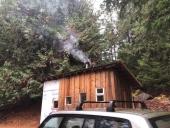
 1
1








best regards, Byron




Garnet Morgan wrote:I am planning on replacing my small, top-loading, inefficient, and otherwise crappy wood stove this summer. I would like to use the existing chimney,

Byron Campbell wrote:It's a lot of work, however. For an idea of about what you're getting yourself into check out this example. Here's a mostly step by step MHA workshop build of a compact footprint bell heater, with hot plate, and a black oven:
http://www.mha-net.org/docs/v8n2/wildac12g.htm














![Filename: pileoftiles.jpg
Description: a pile of mechanicly made roof tiles. [Thumbnail for pileoftiles.jpg]](/t/44407/a/26112/pileoftiles.jpg)
God of procrastination https://www.youtube.com/watch?v=q1EoT9sedqY




William Bronson wrote: The bell and masonry stove shown use a lot of fire brick to line their insides. To me, that is where cob might be a useful choice, as a lining.
William Bronson wrote: The woodfired oven enthusiasts have a lot to say about materials and heat.




Satamax Antone wrote:First, check thoses links.
https://permies.com/forums/posts/list/43528#344410
Satamax Antone wrote:And if you want a cheap bell, my opinion is to get either barrels, or square/rectangular metallic tanks, like old home heating fuel tanks, or tractor fuel tanks. And use thoses as single or multiple bells,. Covered with whatever material you can. If protected by a thin sheet of metal inside, even concrete can work well enough. So a whole lot of choice are availlable to you. Stones, bricks, even cheapish ones, you don't need firebricks in that case.





 Some stones are refractory, like white quartzite. Some other ones are tough enough. Like slate/shale. You can make a "refractory cob", out of clay, sand ans sawdust, or finely chopped straw. Or even wood ashes, or coal ashes. Proportions are hard to get tho. Or you can also add grog (chamotte) to toughen the mix. The insides of a bell rarely exceed 600C° i think. That's too high for concrete, but well within the range of clay mixes.
Some stones are refractory, like white quartzite. Some other ones are tough enough. Like slate/shale. You can make a "refractory cob", out of clay, sand ans sawdust, or finely chopped straw. Or even wood ashes, or coal ashes. Proportions are hard to get tho. Or you can also add grog (chamotte) to toughen the mix. The insides of a bell rarely exceed 600C° i think. That's too high for concrete, but well within the range of clay mixes.
God of procrastination https://www.youtube.com/watch?v=q1EoT9sedqY

| I agree. Here's the link: http://stoves2.com |







